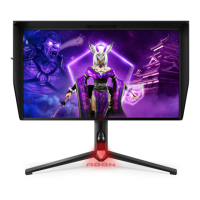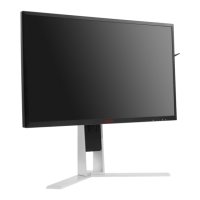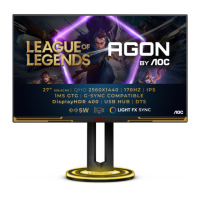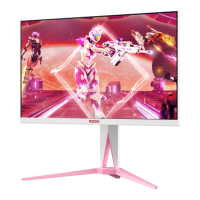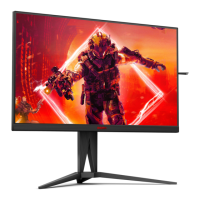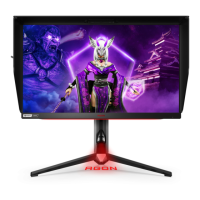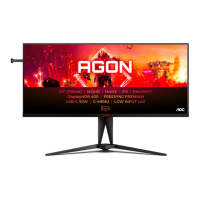
Do you have a question about the AOC AGON PRO AG276QZD and is the answer not in the manual?
| Panel type | - |
|---|---|
| Color gamut | 98.5 % |
| Pixel pitch | 0.2292 x 0.2292 mm |
| Screen shape | Flat |
| Response time | 0.03 ms |
| Backlight type | W-LED |
| Display diagonal | 26.5 \ |
| Surface hardness | 2H |
| Anti-glare screen | Yes |
| Display technology | OLED |
| Native aspect ratio | 16:9 |
| Maximum refresh rate | 240 Hz |
| Viewable size, vertical | 330 mm |
| sRGB coverage (typical) | 100 % |
| Contrast ratio (dynamic) | 80000000:1 |
| Contrast ratio (typical) | 1500000:1 |
| Display number of colors | 1.07 billion colors |
| Display diagonal (metric) | 67.3 cm |
| Viewable size, horizontal | 586.75 mm |
| Display brightness (typical) | 1000 cd/m² |
| DisplayPort version | 1.4 |
| Headphone connectivity | 3.5 mm |
| RMS rated power | 5 W |
| Energy efficiency scale | A to G |
| Power consumption (off) | 0.3 W |
| Power consumption (standby) | 0.5 W |
| Power consumption (typical) | 35 W |
| Tilt angle range | -5 - 23 ° |
| Cable lock slot type | Kensington |
| Panel mounting interface | 100 x 100 mm |
| Certification | ISO 9241-307 |
| Product color | Black |
| Market positioning | Gaming |
| Exterior finish type | Textured |
| Package depth | 189 mm |
| Package width | 731 mm |
| Package height | 477 mm |
| Package weight | 10330 g |
| USB cable length | 1.8 m |
| Depth (with stand) | 233.9 mm |
|---|---|
| Width (with stand) | 604.4 mm |
| Height (with stand) | 526.6 mm |
| Weight (with stand) | 6410 g |
| Depth (without stand) | 71.3 mm |
| Weight (without stand) | 4910 g |
Defines notation conventions like Notes, Cautions, and Warnings.
Explains the meaning of Note, Notice, and Warning text blocks.
Safety precautions for using the monitor's power supply, including grounding and surge protection.
Various safety warnings, including unusual smells/sounds, ventilation, and handling.
Instructions on how to install the monitor safely, including placement and mounting.
Lists all included accessories and components for the monitor.
Step-by-step instructions for installing and removing the monitor's base.
How to reduce image retention risk on OLED screens.
Recommendations for displaying images to prevent damage.
Details on automatic screen compensation and image retention elimination.
How to adjust the monitor's tilt for optimal viewing.
Step-by-step instructions for connecting the monitor to a computer.
Overview of the monitor's control buttons and their functions.
Explains how to use the buttons to navigate OSD menus.
Information on using the G-SYNC Compatible feature.
Information on using the Adaptive-Sync feature.
Explains HDR10 compatibility and how to enable/disable it.
Options for different game modes like FPS, RTS, and Racing.
Adjusts the contrast and backlight brightness of the display.
Selects color spaces like Panel Native, sRGB, DCI-P3.
Configures PIP settings, including sources, size, and position.
Adjusts the audio volume level.
Selects different modes and patterns for the ambient lighting.
Explains LEA, Orbit, Off RS, and Off Timer functions.
Selects OSD language, display time, DP version, and transparency.
Lists common problems like no power, no image, or signal errors.
Detailed technical specifications for the monitor.
Lists standard and advanced display modes with resolutions and frequencies.
Pinout details for the 19-pin and 20-pin display signal cables.
Explains VESA DDC2B functionality for display identification.



